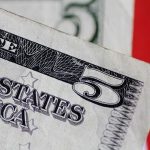
SINGAPORE/LONDON (Reuters) -The dollar rose to a two-month high against its major peers on Monday as traders clawed back bets for aggressive rate cuts by the Federal Reserve this year.
The Fed repricing has followed Friday’s blockbuster U.S. jobs report that far exceeded market expectations and sent U.S. bond yields soaring, boosting the country’s currency.
Treasury yields rose further on Monday after Fed Chair Jerome Powell said the central bank could “give it some time” before cutting interest rates.
Japan’s yen fell to its lowest since early December in early Asia trade at 148.82 per dollar, before steadying to stand at 148.43.
Meanwhile, the euro was last down 0.26% at $1.0762, around its lowest since mid-December.
The moves helped push the dollar index up 0.12% to 104.17, its highest since Dec. 11.
“Markets continue to be bounced around by data and central bank speak,” said Chris Turner, global head of markets at ING.
“Friday’s surprisingly strong U.S. jobs data questions the Fed’s view that the labour market is coming into better balance.”
In an interview with the CBS news show “60 Minutes” that aired on Sunday night and was conducted on Thursday, Powell said the Fed could be “prudent” in deciding when to cut its benchmark interest rate.
He said a strong economy allowed central bankers time to build confidence that inflation would continue to slow.
“Reasons for a bullish USD trend continue to multiply… and now markets having to seriously reassess Powell’s pushback to March rate cut pricing,” said Charu Chanana, head of FX strategy at Saxo Bank.
RATE CUT EXPECTATIONS
Fed funds futures now show roughly 120 basis points (bps) worth of easing priced in for the Fed this year, down from about 150 bps at the end of last year.
A March cut is now seen as a roughly 16% possibility, down sharply from around 50% a week ago.
Sterling edged down 0.17% to $1.2612, around a two-week low.
The pound showed little reaction to revised data that indicated Britain’s unemployment rate stood at around 3.9% in the three months to November, compared with a previous experimental estimate of 4.2%.
The Aussie was last down 0.16% to $0.6501, after sinking as low as $0.6487 in Asian trading.
Treasury yields rose again on expectations of higher-for-longer U.S. rates, with the two-year yield, which typically reflects near-term interest rate expectations, last up 8 basis points at 4.445%, after jumping 18 bps on Friday.
Elsewhere, China’s central bank continued to use the official guidance fix to keep its currency stable, after setting the midpoint rate for the yuan 1018 pips firmer than Reuters’ estimate, the biggest discrepancy since November 2023.
That supported the onshore yuan slightly, though it still struggled against a stronger greenback and finished the domestic session at 7.1982 per dollar, the weakest close since Nov. 17.
The main event on the economic calendar is the ISM non-manufacturing survey due later in the day, which will give a sense of the health of the U.S. economy in January.
Data on Monday showed that German exports fell more than expected in December due to weak global demand.
To read the full article, Click Here

